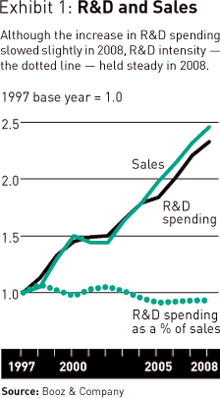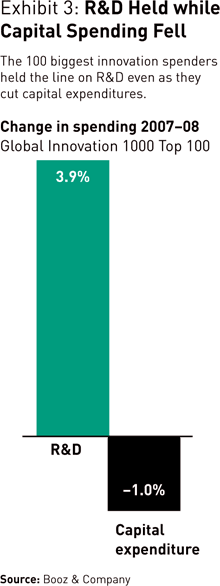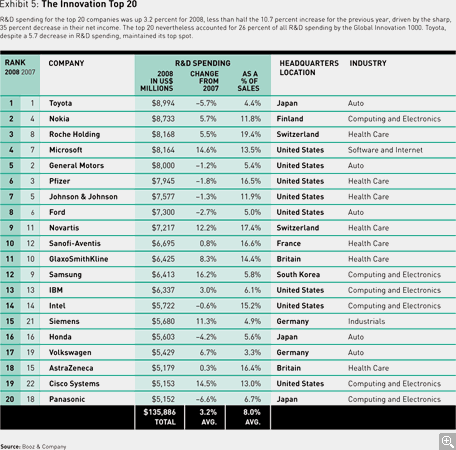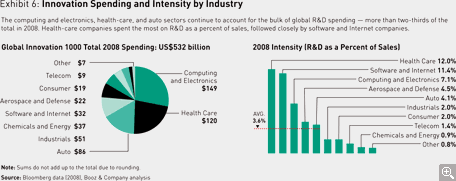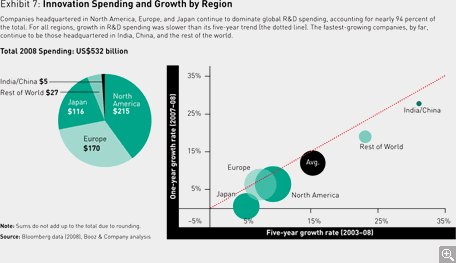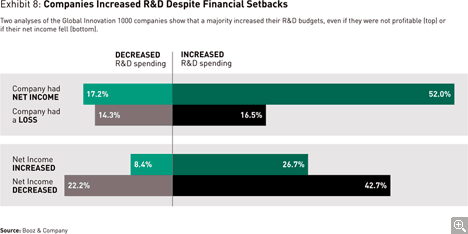Profits Down, Spending Steady: The Global Innovation 1000
Booz & Company’s annual study of the world’s biggest corporate R&D spenders finds that most companies have stuck with their innovation programs despite the recession — and many are boosting spending to compete more effectively in the upturn.
One of many unknowns as the economy plunged into the Great Recession was whether corporate leaders would put their money where their mouths were regarding research and development. For years, managers have maintained that R&D spending is a competitive necessity — not a discretionary activity that could be cut to prop up earnings during hard times. Skeptics, on the other hand, suspected that companies would cut their R&D budgets at the first sign of red ink. This year’s Global Innovation 1000 survey provides the first comprehensive empirical answer to the question: The world’s biggest innovation spenders indeed walked the walk in 2008. R&D spending rose 5.7 percent in 2008, a slower rate of growth than the prior year’s 10 percent increase, but in line with the group’s 6.5 percent increase in worldwide sales. (See Exhibit 1.) And that increase in spending looks even more impressive given that operating income for the group fell 8.6 percent in 2008, and net income plummeted 34 percent.
More than two-thirds of the companies included in this year’s Global Innovation 1000 maintained or increased R&D spending in 2008, and even though a third of the companies reported a financial loss for the year, we found no correlation between financial losses and reductions in R&D spending. Furthermore, our analysis revealed that innovation investment is increasingly viewed as essential to corporate strategy: More than 90 percent of executives we surveyed said innovation is critical as they prepare for the upturn, and a majority have maintained or expanded their portfolios and are pursuing new products to improve growth and margins. (See Exhibit 2.)

“Innovation is what drives our competitive position in all three of our markets — automotive, professional, and consumer — and therefore we can’t back off,” says Robert Lardon, corporate vice president for strategy and investor relations at Harman International Industries Inc. Adalio Sanchez, general manager of IBM’s System X server business, echoes that point of view: “I would argue that the recession is a catalyst for increased innovation.”
These anecdotal observations confirm the data in this year’s Global Innovation 1000, the fifth of our annual analyses of corporate spending on innovation and its connection to corporate performance. As in previous years, we identified the 1,000 public corporations worldwide that spent the most on researching and developing products and services for their marketplace. In addition, this year we conducted a special survey of nearly 300 senior managers and R&D leaders from 230 companies, which collectively spent more than US$230 billion on R&D in 2008, asking them detailed questions about their companies’ response to the recession, and followed up with in-depth interviews with a number of top R&D executives.
Not all companies, of course, maintained or boosted R&D spending. More than a quarter of the Global Innovation 1000 cut their innovation budgets in 2008. And many companies were cautious: The top 20 innovation spenders increased research and development by only 3.2 percent, compared with 10.7 percent for these companies in the previous year. Furthermore, the early evidence indicates that as companies entered 2009, spending on innovation slowed further. Again, however, that slowdown came in the face of even steeper declines in sales and income: Among the 522 companies reporting results for the first quarter of 2009, R&D spending decreased by 7.4 percent — which is still less than half the rate of their 18.5 percent decline in sales. Also noteworthy is that as the biggest R&D spenders have evaluated their investment strategies in the downturn, they have continued to invest in R&D at a higher rate than they have in capital expenditures. (See Exhibit 3.)
We believe there are three primary reasons companies are so reluctant to cut innovation spending when times are extremely tough.
1. Innovation has become a core component of overall corporate strategy. Given the fierce nature of business competition in recent years, a reduction in innovation efforts would be akin to unilateral disarmament in wartime.
2. Companies in most sectors are typically committed to product development cycles that extend for many years — well beyond the length of an average recession. If they are suppliers, they have often already contracted to help develop their customers’ next new model; if they sell to consumers, missing an innovation cycle can mean being put out of the game entirely.
3. Many companies see the recession as an opportunity to build their advantage over their competitors — especially weaker ones that may have to skimp on R&D for financial reasons. If the stronger companies can maintain the pace of innovation, the thinking goes, they may be able to gain market share quickly once the upturn gets under way in earnest.
At the same time, even companies that are maintaining or increasing R&D spending are responding to the effects of the recession. Every one of the top executives we interviewed said their companies are working hard to spend smarter — to get more bang for their R&D buck. We see three general trends that have either originated with the recession or accelerated during its course.
- As a rule, companies are performing less pure and applied research. Instead, they are concentrating their R&D budgets on product development and engineering. This has been a trend for several years — indeed, 44 percent of survey respondents said they spend less than 20 percent of their R&D budget on basic research and advanced development — but it became even more pronounced during the recession. Managers hope to bring new products to market to take advantage of the upcoming recovery. Nearly 40 percent of respondents said their companies are shifting resources from basic research in order to prioritize new product launches.
- The downturn has encouraged many companies — 40 percent, in our survey — to speed up their efforts to make the innovation process more efficient.
- In response to the downturn, companies have become more risk averse; nearly half of survey respondents say that their companies are now more conservative than before. Companies are changing the criteria they use when giving new products the green light, tightening their relationships with customers and consumers, and watching their competitors, and the marketplace, more carefully.
Although the downturn’s effects on global innovation efforts have thus been mixed, many companies clearly expect that by standing fast, they can gain a significant competitive edge over their more cautious rivals, both now and in the coming recovery.
Profiling the 2008 Global Innovation 1000
Even during the recession, the companies in this year’s Global Innovation 1000 study increased their R&D spending in 2008 by 5.7 percent, to US$532 billion. This is significantly less than 2007’s 10 percent increase over the prior year, but it is close to the 7.1 percent five-year compound annual growth rate for the Global Innovation 1000. R&D spending rose in 2008 despite the fact that almost a third of the companies in our study reported net losses for the year, and overall sales were up just 6.5 percent, considerably less than the prior year’s 10 percent increase. R&D intensity in 2008 — the percentage of sales devoted to R&D — remained the same as in 2007 for these companies, at 3.6 percent. We estimate that this year’s total spend of the Global Innovation 1000 companies represents 81 percent of global corporate R&D spending of approximately $660 billion, and a little more than 50 percent of total worldwide R&D spending, including that of governments, of $1.05 trillion. (See Exhibit 4.)
The Toyota Motor Corporation was the #1 spender on R&D for the third straight year, with a budget of just under $9 billion. The company maintained its rank despite its first-ever loss, more than $4.3 billion in 2008. Toyota’s R&D spending was 5.7 percent lower, however, than it was in 2007. The #1000 company on our list was the Laird Group PLC, a London-based maker of electronics equipment, which spent $58 million on R&D. The top 20 companies increased R&D spending just 3.2 percent in 2008, compared to 10.7 percent in the prior year — no doubt because net income among the 20 fell from $115 billion in 2007 to just $75 billion in 2008, a startling 35 percent drop. (Even subtracting the General Motors Corporation’s 2008 loss of more than $30 billion, net income for the group fell 9 percent.) Still, the top 20 spenders accounted for 26 percent of spending by the entire Global Innovation 1000. Three companies fell out of the top 20: Matsushita was acquired by Panasonic; Merck and Sony were replaced by Siemens and Cisco Systems, both of which boosted R&D spending in 2008 by more than 10 percent. (See Exhibit 5.)
The computing and electronics industry retained its top spot in R&D spending among the industry sectors, spending $149 billion, accounting for 28 percent of the total spend. As in previous years, health care and auto came in second and third, spending 23 percent and 16 percent, respectively. Notwithstanding the massive decline in sales that the auto industry has faced since the spring of 2008, R&D spending in the industry increased, but only by 0.6 percent. Aerospace and defense was the only industry to see R&D spending fall, by 2.3 percent for the companies on this year’s list. Changes in R&D intensity, however, varied: Five industries — auto, computing and electronics, consumer, industrials, and health care — increased their R&D intensity, while telecom, software and Internet, aerospace and defense, and chemicals and energy decreased theirs. A 1.4 percent increase in intensity, to 12 percent, allowed health care to take over the top spot in R&D intensity this year, and chemicals and energy decreased its intensity by 10.4 percent, to 0.9 percent, the lowest of all the industries. (See Exhibit 6.)
Companies headquartered in the three major regions — North America, Europe, and Japan — continued to account for 94 percent of the total R&D spending of the Global Innovation 1000, and every region, including China and India and the rest of the world, increased its spending. However, the rates of regional spending growth were slower. Japan increased its spending by just 0.5 percent, Europe by 6.3 percent, and North America by 6.5 percent; the global five-year compound annual growth rate was 7.2 percent. (See Exhibit 7.) Overall, the recession has had a noticeable, but relatively mild, effect on R&D spending thus far. Given the weak growth in both overall sales and net income, it’s no surprise that companies are spending somewhat more cautiously on innovation. But if that means the downturn is forcing companies to spend those innovation dollars more effectively, that’s all for the better.
— B.J. and K.D.
Recessionary Effects
The downturn has taken a major toll on the worldwide economy, and the companies that make up the Global Innovation 1000 have certainly not been immune to its impact. Overall, they spent $532 billion on R&D in 2008, a healthy 5.7 percent increase over 2007, but well below the 10 percent increase from 2006 to 2007. Total sales were up 6.5 percent, to $15 trillion — but again, it was a significantly smaller increase than the 10 percent gain this same group registered between 2006 and 2007. Thus the group’s R&D intensity — innovation spending as a percentage of sales — remained the same at 3.6 percent. And our analysis shows, as it has every year over the last five years, that the amount of money companies spend on R&D bears no relationship to overall corporate performance.
The effect of the downturn varied significantly by industry, and no industry has felt the pain more than autos. Nine out of the top 10 R&D spenders in the automotive sector cut their innovation outlays in 2008; the Toyota Motor Corporation, for instance, which suffered the first loss in its history, reduced its R&D spending by nearly 6 percent, though it still maintains its position as the #1 global spender on innovation. The software and Internet sector, on the other hand, clearly sees the recession as an opportunity. Fully eight out of the industry’s top 10 innovation spenders increased their R&D spending in 2008. And innovation spending in the computing and electronics industry was up more than 4 percent, though the proportion of companies that increased R&D spending was essentially unchanged from last year.
Even companies that are losing money are not necessarily cutting back on their R&D spending. Almost a third of the companies in the Global Innovation 1000 reported losses in 2008, yet those companies were slightly less likely to decrease R&D spending than they were to increase it. (See Exhibit 8.) No matter what the impact of the recession, a large percentage of the 1,000 companies we analyzed continue to view their efforts to innovate as a critical element of their overall corporate strategy.
The Strategic Imperative
The results of this year’s additional survey of 290 senior executives and R&D leaders confirm the vital role that innovation plays in corporate strategy, and suggest that innovation spending is likely to hold up through 2009 as well. Fully 70 percent of respondents said their companies were planning to either maintain or increase their spending on research and development during 2009, and nearly three-quarters reported that they had maintained or expanded their innovation portfolios during the recession.
In several cases, the looming specter of recession became an inducement to greater innovation efforts. The $6.3 billion mail services company Pitney Bowes Inc., for example, made a decision to invest more in innovation in the months leading up to the downturn. Managers concluded that the company’s financial strength would allow it to increase R&D spending, and they knew that doing so would put Pitney Bowes in an even better competitive position once the recovery began. (See “Integrated Innovation at Pitney Bowes,” by David Dobson.)
Even companies facing business challenges feel they cannot back off on their innovation efforts. Hans Stork, who oversees innovation at Applied Materials Inc.’s silicon unit, which makes equipment used to manufacture semiconductors, says his revenues are down significantly this year. Yet his customers continue to demand innovative new products to maintain their own competitive positions. “Our customers don’t seem to slow down,” he says. “One would think that if there is less demand and less money available, that somewhere things would have to slow down. But their competitive nature plays tricks with that. The stronger companies want to stay on the same innovation page so that at the end of the cycle, they have a stronger competitive position.”
Indeed, for many companies, the recession has catalyzed innovation, by forcing them to think more carefully about their new product portfolios and their innovation processes and costs. Notes IBM’s Sanchez: “When you’re in a situation where you’ve really got to be judicious, to do more with less, that really drives a need for innovation and a level of creativity that you might not otherwise have in normal times. Increased innovation doesn’t always have to be about more dollars. It’s about how you use those dollars and how you accelerate some products just to bring them out.”
Products and Cycles
Every innovation executive we interviewed cited the constraints of the product development life cycle as an additional reason that R&D spending could not be cut in the short term. The reason is simple: The length of time it takes to develop a new product varies significantly from industry to industry, but it is measured in years rather than months. A new car, for example, can take up to four years, and a new drug more than a decade. Yet the typical recession rarely lasts more than a year. That dynamic has been a significant force in mitigating the negative impact of this recession on innovation spending. (See Exhibit 9.)
Harman International is a $3 billion maker of high-end car audio and “infotainment” systems, as well as professional and consumer audio equipment, with 75 percent of its sales coming from the automakers. As the company entered the recession, it was in the process of developing 13 different car systems for automakers, none of which could be delayed. “Through this downturn, we’ve had more engineering in terms of new infotainment platforms than in the history of any infotainment supplier,” says Harman’s Lardon. “These programs have to be started from one to three years in advance of their actual launch. The number of cars sold, of course, is down, and that’s been reflected in our top-line revenue. But that didn’t mean that we could reduce the engineering during this time. We had to get these things out to launch.”
The competitive dynamics of the computer and electronics sector can be even more intense. IBM’s Sanchez, who runs the unit that makes Intel-based servers, notes that the product generations in his business sometimes take longer to develop than the products themselves last in the market, so the product development cycle demands constant refreshment. “You cannot all of a sudden just dry up the investment pipeline,” he says, “because in this particular segment of the marketplace, if you miss a cycle, you’re out of the market.”
That doesn’t mean, however, that product development cycles can’t be shifted in response to the economic cycle. Alan Grant, senior vice president for R&D in developing markets at Kraft Foods Inc., concurs with the view that development cycles can be inflexible — even in consumer packaged goods, where companies develop thousands of products every year. “The reality is that given the retail cycle, our [corporate] customers — if not our consumers — expect us to bring to the market some level of innovation in core categories at various times of the year,” he notes. At the same time, however, the downturn has forced Kraft to make smarter decisions about the timing of product launches. “Before the recession,” says Grant, “some of our developing-market businesses were considering some new premium initiatives. We never actually stopped development work on these products, but in some cases we chose to delay their launch and focus instead on launching more price-sensitive products to deal with the drop in consumer purchasing power.”
Innovating for the Upturn
Ultimately, to be sure, the global economy will recover; some economic forecasters argue that the recovery began in the summer of 2009. The executives we spoke with emphasized the need to remain competitive, and to make sure they’re ready for the recovery. That’s when those companies that have succeeded in maintaining the pace of innovation, such as Harman International, will find themselves at a real competitive advantage. Says Harman VP Lardon, “When we emerge from this downturn, we will emerge leaner, more efficient, and more technologically capable. This has been both a business mandate and a cultural imperative for us. Being an innovation leader and having a best-in-class cost structure are not mutually exclusive.”
To that end, during the recession, Harman — whose branded car audio and premium infotainment systems have been designed primarily for the high-end auto market — turned to its Chinese and Indian R&D teams to help build a new, “clean sheet” mid-priced infotainment system. It was developed independently of any auto manufacturer, in record time, at substantially lower cost. The system can be incorporated into a new vehicle within a year, compared to the two to three years the process usually takes, speeding time-to-market and saving considerable expense. Lardon believes the new system will position his company particularly well to profit from the recovery in the auto industry, especially in Asia, whose auto markets have strong growth prospects.
The General Motors Corporation, despite all its struggles in the past year, is also looking to the future. As it came out of bankruptcy in the summer of 2009, the company had to significantly cut back on R&D, in part because it so radically slimmed down its brand lineup. Still, says Alan Taub, who as GM’s vice president of global research and development has responsibility for the company’s advanced research, “doing so gave us the opportunity to clean up our priorities. We’ve done that, and now we’re back to executing.” What Taub’s group is executing on, however, has changed as well. As GM looks to shift its cultural focus from products to consumers, Taub’s team is at the center of the cultural shift, working not just on the total vehicle experience, but also on how better to understand what GM’s customers want.
The ROI of Innovation
Despite the opportunities the downturn has opened up for stronger players, nearly every company has been affected by the slowdown in some way. Even those companies that have not cut innovation spending dramatically are trimming here and there, tightening management processes and reassessing their product development portfolios. More than 40 percent of the respondents to our survey said they have become more conservative in their approach to innovation, and 70 percent reported that they were adjusting their strategy to better capture changing customer requirements.
The goal for nearly all the R&D executives we spoke with is to improve the returns on their innovation investments, in both the short term and the long. More than 40 percent of survey respondents said their companies were focusing on process improvements to change R&D spend during the downturn, and a similar number reported that they were getting better at killing bad projects. More than a third of companies surveyed, for instance, said they were terminating more exploratory projects that lacked specific timelines, and more than 40 percent said their companies were focusing more on newer products that have the potential to grow faster. “For the past two or three years, we have been looking at our R&D portfolio, focusing on fewer, bigger ideas as opposed to lots of incremental little things,” says Kraft Foods’ Alan Grant. “What the recession has done is change the filters through which we view the portfolio. Which of these products might we bring to the front and which might we choose to backpedal on, given the challenging economic times?”
Or consider the case of Applied Materials, which faces an unusually difficult innovation environment. Thanks to the recession, quarterly revenues for all the top manufacturers of wafer equipment dropped by nearly 80 percent from their peak quarter in 2007 to their bottom quarter in 2009. As a result, nearly every company’s R&D spending has rapidly outpaced revenues, and now companies must either bring that R&D spending down dramatically or grow revenue quickly. Meanwhile, the pressure to innovate in the chip business keeps increasing as the size of semiconductors becomes ever smaller, and Applied Materials’ silicon group finds itself having to spend more and more money on R&D to get the same results.
In response, the company has pulled all the internal levers it can, cutting back on controllable expenditures, paring down low-priority projects, and focusing more on its most significant customers. Ultimately, however, that won’t be enough, says innovation leader Stork. Under these circumstances, survival is more a matter of the economics of competition. “R&D is not only a function of revenue but also of what your competitors do,” he says, “and that changes how you look at the metrics that relate to innovation ROI [return on investment]. How large is the market? What market share do you have today? What growth is there in the market itself? How is your competitor positioned? Do you have a chance to grow there? All of the strong players in this recession are looking over their shoulders at what the other guys are doing.”
Few companies face Applied Materials’ combination of extreme pressure to innovate and significantly declining revenues. So the company’s decision to diversify into other businesses, most notably solar panels, is especially fortuitous. Doing so, Stork notes, allows Applied Materials to transfer its R&D expertise in silicon to other technologies with similar requirements. That kind of thinking is critical in an economic environment that rewards getting that slight extra boost from your R&D efforts.
The Downturn’s Upside
Judging from the data in this year’s study, the results of our survey, and our conversations with executives, the recession’s effect on innovation activity has not been as severe as some observers of the business scene might have anticipated. Innovation has become central to every company’s efforts to compete, and the degree of competition has been in no sense reduced by the downturn; if anything, it has been heightened. Long product development cycles have forced companies to maintain their R&D spending even when revenues decline. And most companies are fully aware of the need to be in position to profit from the coming upturn.
In many ways, the recession has forced the corporate sector to improve its approach to innovation. Virtually all the companies we contacted noted that they have learned to streamline R&D processes, to make sure their product development filters more effectively reflect economic reality, to make smart bets on advantaged technologies, and to kill weak projects more quickly. All these changes should help them get more from their R&D investments over time.
As we head into a better business environment, smart companies will see this recession as a learning experience. Every company should take the time to assess the strengths and weaknesses of its innovation systems and processes. The downturn no doubt revealed some major gaps in innovation capabilities. Fix them now. Doing so right away will pay dividends in terms of speed-to-market, quality of execution, and capacity — both in the coming upturn and well into the future. ![]()
Booz & Company Global Innovation 1000: Methodology
Booz & Company identified the 1,000 public companies around the world that spent the most on research and development in 2008. To be included, companies had to make data on their R&D spending public; all data is based on the last full-year data reported by June 30, 2009. Subsidiaries more than 50 percent owned by a single corporate parent were excluded because their financial results are included in the parent company’s reporting. This is the same core approach we have used in the previous four years of the study.
For each of the top 1,000 companies, we obtained key financial metrics for 2001 through 2008, including sales, gross profit, operating profit, net profit, R&D expenditures, and market capitalization. All foreign currency sales and R&D expenditure figures through 2008 were translated into U.S. dollars at the average exchange rate for the respective year. In addition, total shareholder return was gathered and adjusted for each company’s corresponding local market. Exchange rate fluctuations in the list itself may affect comparison with prior years’ studies.
Each company was coded into one of nine industry sectors (or “other”) according to Bloomberg’s industry designations, and into one of five regional designations as determined by each company’s reported headquarters location. To enable meaningful comparisons across industries, we indexed the R&D spending levels and financial performance metrics of each company against its industry group’s median values.
To understand more about the impact of the recent economic downturn on innovation spending and strategy, we also conducted a Web-based survey of more than 290 senior managers and R&D professionals from 230 different companies around the globe. The companies participating represented more than US$230 billion in R&D spending, or 44 percent of the total Global Innovation 1000 R&D spending for 2008. Respondents came from all the industry sectors; geographically, 49 percent came from North America, 38 percent from Europe, 13 percent from Asia, and less than 1 percent from the rest of the world.
Reprint No. 09404
Author profiles:
- Barry Jaruzelski is a partner with Booz & Company in Florham Park, N.J., who leads the firm’s work for high-technology and industrial clients. He has spent more than 20 years working with clients, specializing in corporate and product strategy, product development efficiency and effectiveness, and the transformation of core innovation processes.
- Kevin Dehoff is a partner with Booz & Company in Florham Park, N.J., and is the global leader of the firm’s innovation business. He has spent more than 15 years helping clients drive growth and improve performance through innovation, in areas including research and development, technology management, product planning, and new product development.
- Also contributing to this article was consulting editor Edward H. Baker.


